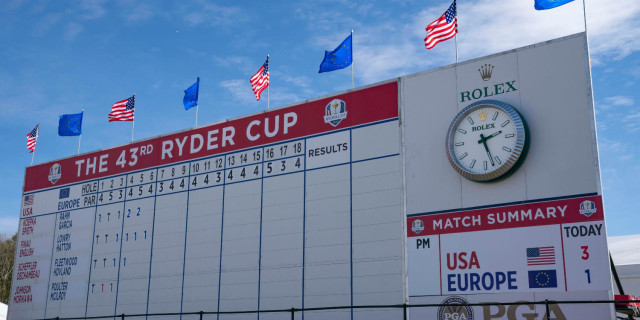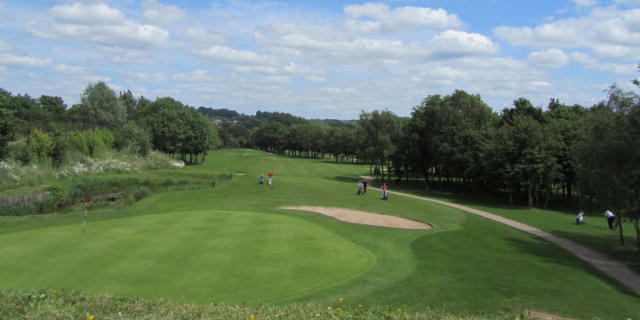
Hole-by-Hole Guide to Bellerive Country Club
This year's PGA Championship is being contested at Bellerive Country Club in Missouri. The course has previously hosted the PGA in 1992, when Nick Price won, and the 1965 U.S. Open, secured by Gary Player as he completed the career Grand Slam. Now, major golf has returned, and we take a look at the 18 holes that make up this 7,329 yard layout.
1st, 425 yards, par 4: A tricky opening hole featuring a crowned fairway laid on top of a former graveyard. The fairway is squeezed by bunkers at the landing area around 300 yards off the tee but a wide green awaits approach shots.
2nd, 410 yards, par 4: A hole which underwent major changes in 2006, with an existing creek transformed into a lake which will catch a pulled tee shot or approach. A good birdie opportunity if players can find the fairway.
3rd, 148 yards, par 3: More water features on the shortest hole of the course, with a lake guarding the front and right side of a green which features a ridge to funnel shots to pin positions on the left, possibly setting up a hole-in-one.
4th, 521 yards, par 4: A par five for the members, the fourth favours a right-to-left shape off the tee to avoid fairway bunkers and set up a long second shot to a green protected by more sand.
5th, 471 yards, par 4: Another draw may be required off the tee to keep the ball in a fairway which slopes from left to right. A wide green is protected by two bunkers short and right and another on the left.
6th, 213 yards, par 3: The second par three on the course is far tougher than the first and played to stroke average of 4.03 during the 1965 US Open. The green has been made even smaller since the renovation and with water on the right, the bunkers on the left could see plenty of action.
7th, 394 yards, par 4: After a few tough holes the seventh offers some welcome respite and an accurate tee shot will leave most players with just a wedge into the green, although a creek lurks behind and left of the putting surface.
8th, 610 yards, par 5: One of just two par fives and not exactly an easy birdie opportunity, although a fairway bunker on the corner of the dogleg has been removed. A creek down the right of the hole is a factor when laying up to set up the approach to a wide but shallow green.
9th, 433 yards, par 4: Finding a fairway guarded by two bunkers is just part of the problem on the ninth, which features an uphill approach to the most undulating green on the course, where more sand and a run-off area to the left await an errant approach.
10th, 508 yards, par 4: Another hole which plays as a par five for the members and finding the fairway on this dogleg left is crucial, with a creek crossing the hole around 50 yards short of the green waiting to catch any mishit approach from the rough.
11th, 355 yards, par 4: A risk-reward par four which could be set up shorter than its full yardage to encourage players to attempt to drive the green. However, that green has a narrow entrance and is protected by a pond on the right, so discretion may be advised.
12th, 452 yards, par 4: An elevated tee gives a good look at the fairway bunkers on the left which guard the corner of the dogleg, while the lengthy green saw Nick Price hole from 105 feet for birdie on his way to victory in the 1992 US PGA.
13th, 180 yards, par 3: Pin positions will dictate the difficulty of this par three, with plenty of birdies possible if the hole is cut on the accessible left side of the green. Pins on the back right of the green bring a large bunker and creek into play.
14th, 410 yards, par 4: The start of a three-hole stretch, known as “The Ridge”, which play into the prevailing wind. Players missing the fairway left risk being blocked out by trees but otherwise this is a good birdie opportunity.
15th, 495 yards, par 4: A tough par four which will usually require players to hit driver off the tee and avoid the sole fairway bunker to set up an approach to a wide but relatively shallow green which slopes from right to left.
16th, 237 yards, par 3: Two large bunkers in front of the green lie in wait for any tee shot which fails to make the long carry and those hazards can expect to see plenty of action if the pin is on the front.
17th, 597 yards, par 5: A potentially decisive hole with two tee boxes which could see the length vary from almost 600 yards to around 530. A creek runs down the right of the hole and the green is divided into three sections.
18th, 457 yards, par 4: Bigger hitters could try to carry the fairway bunkers on the left, but most players will lay up short of those on the right. The green is surrounded by four bunkers, with a back-right pin position the toughest to get close to.

Be part of the action with a selection of unique golf tournament experiences, from playing in a pro-am with the stars to watching the action at golf’s most illustrious events. Whether it’s the Masters or The Open, The Ryder Cup or WM Phoenix Open, build your own bespoke package with the experts at Golfbreaks.com.









